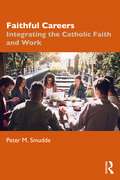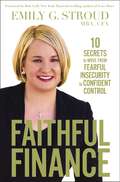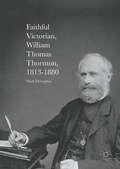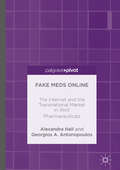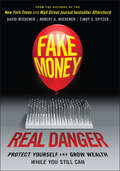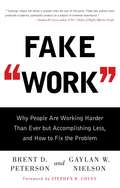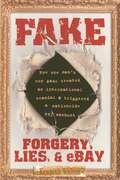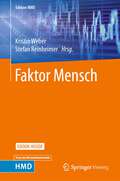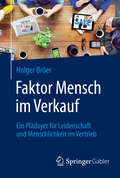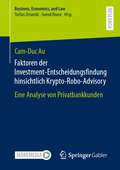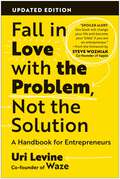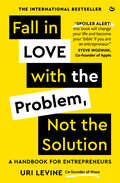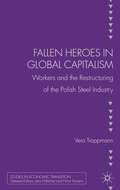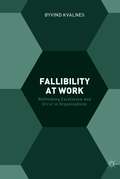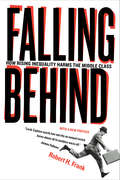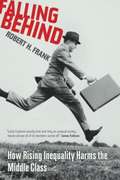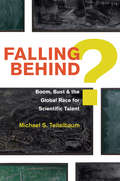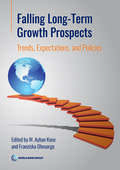- Table View
- List View
Faithful Careers: Integrating the Catholic Faith and Work
by Peter M. SmuddeIn Faithful Careers Peter M. Smudde contends that God calls us to live an "integrated life" that unifies both the spiritual and the secular aspects of life. As an introduction to integrating the Catholic faith with one’s work, this book answers, in the Catholic context, basic questions of what work is, why work is important, who we are as workers, how may we have fruitful careers, where may we find help about faith-work integration, and when we should take next steps toward better integrating our work and the Catholic faith. Smudde demonstrates how the Catholic faith truly does apply to our labor, and that our lives depend on that labor, by putting forth particular matters of the faith that pertain to faithful careers. He then puts into real-world context, pertinent teachings, concepts, principles, practices, and other means the Catholic Church provides for us, so that those lessons can be practically applied on a daily basis. Sources such as the Bible and writings of the saints, popes, contemporary Catholic spiritual writers, apologists, and scholars are applied to strengthen the support made about the book’s content. Catholic professionals at all stages of their careers will welcome this insightful book, which explores the call to put spirituality in the foreground—to obtain ever-deeper faith and, thereby, greater integration of faith in everyday life and career.
Faithful Finance: 10 Secrets to Move from Fearful Insecurity to Confident Control
by Bob Goff Emily G. StroudMany of us feel overwhelmed and ill-equipped to deal with our personal finances. We wonder if we will ever experience financial freedom. We want to make wise decisions and spend money on what matters, but we just don’t know how.Financial advisor Emily G. Stroud is a mom, businesswoman, and entrepreneur. She has two decades of experience with helping people make smart choices about money. She knows that money can be one of the great causes of stress in life—but that it doesn’t have to be that way. Finances, in fact, can be a great source of joy, security, and hope.In Faithful Finance, Emily comes alongside you to:Develop a savings plan based on your unique goalsMake a monthly budget that actually works for youReduce your overall debt burdenPlan for your children’s college yearsInsure your life without fearLeave a legacy through estate planningEncourage you to give generouslyAnd most importantly, discover the source of true wealthPresented in a conversational style, this practical guide offers ten life-changing secrets that work in every financial situation, for every income level, at every stage of life. With engaging stories and practical examples, Emily empowers you to make choices that will allow you and your loved ones to enjoy financial freedom for years to come.
Faithful Victorian
by Mark DonoghueThis book weaves William Thomas Thornton'slife story into the larger themes of his diverse writings whose purpose was toexpose ambiguities and contradictions in politics, economics, metaphysics andreligion. Thornton was a poet, an intrepid traveler, abiographer, an essayist, an imperial mandarin, and a dutiful family man. Thorntonjoined the East India Company in the mid-1830s, rising to become Secretary ofthe India Office's Department of Public Works. Thisstudy uses Thornton's letters and other recently-discovered primary material toprovide a fascinating account that returns his compelling life to the center ofnineteenth-century British intellectual thought.
Fake Meds Online
by Alexandra Hall Georgios A. AntonopoulosThis book provides a timely criminological investigation into the rapidly growing sale of fake medicines online. Some estimates suggest that the fake medicine trade has now overtaken marijuana and prostitution as the world's largest market for criminal traffickers. This increase has been particularly apparent in the context of various evolutionary phases in information and communications technologies, and the Internet now acts as the main avenue through which this criminal market is expanding. Thus far - despite growing concern and media attention - this extensive, extremely profitable, and ultimately life-threatening online market is yet to be fully explored. Drawing on the authors' own criminological investigation of both the supply and demand sides in the United Kingdom, this study offers the first in-depth and empirically-grounded analysis of the online trade in illicit medicines. Founded on rigorous research, and bolstering a rich area for debate, this book will be of particular interest for scholars of criminology and technology studies.
Fake Money, Real Danger: Protect Yourself and Grow Wealth While You Still Can
by David Wiedemer Robert A. Wiedemer Cindy S. SpitzerThe latest must-read book from the authors of the New York Times and Wall Street Journal Bestselling Aftershock series of books, Fake Money, Real Danger strips away the confusion and exposes what’s really happening to our economy and investments—and shows you what to do about it now, before it’s too late. Picking up where Aftershock left off, Fake Money, Real Danger reveals how the Covid-19 pandemic—and the government’s massive money printing and borrowing in response to it—is providing investors with a once in a lifetime opportunity to build wealth in the near term, while also taking the crucial steps necessary to protect yourself and your investments from the inevitable Fake Money bubble pop in the longer term. What FAKE MONEY? Massive government money printing increased the U.S. money supply by more than 1,000% since 2008, printing more money in ONE MONTH in 2020 than during the two years of the Financial Crisis in 2008 and 2009. Mammoth federal debt is now at a staggering $30 trillion—up $3 trillion in 2020 and on track for continuous huge increases. The amount of federal debt is nearing 10 times our annual tax revenues. What REAL DANGER? All U.S. economic growth since the Financial Crisis is entirely due to government borrowing. All of it. Without massive government borrowing we’d have no growth at all. Stock markets will likely continue to rise because of Fake Money but face an inevitable crisis when continued massive money printing creates serious inflation. You and every investor are now at a crossroads. Your next move will decide your fate: protection and profits OR wealth destruction and regret.
Fake News at DER SPIEGEL (A)
by Jonas Heese Tonia Labruyere Aiyesha DeyThe case discusses the strategy of DER SPIEGEL, the leading news magazine in Germany, in the aftermath of the discovery of a fake reporting scandal. It had come to light that one of DER SPIEGEL's own reporters had falsified and made up entire articles for years, despite DER SPIEGEL's large fact-checking departments. New editor-in-chief Steffen Klusmann and an internal investigation commission had set to work to discover the problems within DER SPIEGEL that made this failure possible, and had come up with a series of recommendations for improvement. At the heart of the investigation was the question whether the scandal was the result of one bad apple or whether DER SPIEGEL had systematic failures in its control systems.
Fake News at DER SPIEGEL (B): The Commission's Recommendations
by Jonas Heese Tonia Labruyere Aiyesha DeyThis (B) case serves as a complement to the case "Fake News at DER SPIEGEL (A)".
Fake Work
by Brent D Peterson Gaylan W NielsonHow many countless working hours have you spent on projects, proposals, paperwork, and meetings that felt useless or were ignored or dismissed? Hard work is not the same as real work. Half of the work we do consumes valuable time without strengthening the short- or long-term survival of the organization. In a word, it's fake. Not only does fake work drain a company's resources without improving its bottom line, it steals conviction, care, and positive morale from employees, and adds the burden of high turnover, communication breakdowns, and cultural patterns of poor productivity. But how can you turn fake work into real work? Internationally renowned business consultants Brent D. Peterson and Gaylan W. Nielson explain how to identify needlessly time-consuming and sometimes difficult tasks (which aren't always as easy to spot as they seem) and shift your focus toward rewarding work that will achieve results. With more than twenty years of experience, Peterson and Nielson have successfully helped corporations, government agencies, nonprofits, schools, and community groups increase their productivity and retain talented employees by understanding and using their skills on things that actually matter. They illustrate their advice with stories about real world employees who have been trapped by fake work. Fake Work offers solutions that will change the way you view work, including how to recognize fake work and how to get out of it, how (and what) to communicate with your colleagues to eliminate fake work, how to recognize and counteract the personality traits that encourage fake work, and how to close the gap between your company's strategies and the work that needs to be done to reach the results critical to your and your company's survival.
Fake: Forgery, Lies, & Ebay
by Kenneth WaltonIt was the golden age of eBay. Optimistic bidders went online to the world's largest flea market in droves, ready to spend cash on everything from garden gnomes to Mercedes convertibles. Among them were art collectors willing to spend big money on unseen paintings, hoping to buy valuable pieces of art at below-market prices. EBay also attracted the occasional con artist unable to resist the temptation of abusing a system that prided itself on being "based on trust. " Kenneth Walton -- once a lawyer bound by the ethics of his profession to uphold the law -- was seduced by just such a con artist and, eventually, became one himself. Ripped from the headlines of the New York Times, the first newspaper to break the story, Fake describes Walton's innocent beginnings as an online art-trading hobbyist and details the downward spiral of greed that ultimately led to his federal felony conviction. What started out as a satisfying exercise in reselling thrift store paintings for a profit in order to pay back student loans and mounting credit card debt soon became a fierce addiction to the subtle deception of luring unsuspecting bidders into overpaying for paintings of questionable origins. In a landscape peopled with colorful eccentrics hoping to score museum-quality paintings at bargain prices, Walton entered into a partnership with Ken Fetterman, an unslick (yet somehow very effective) con man. Over the course of eighteen months they managed to take in hundreds of thousands of dollars by selling forged paintings and bidding on their own auctions to drive up the prices. When their deception was discovered and made international headlines, Walton found himself stalked by reporters and federal agents while Fetterman went on the lam, sparking a nationwide FBI manhunt. His elaborate game of cat and mouse lasted nearly three years, until the feds caught up with him after a routine traffic violation and brought him to justice. In this sensational story of the seductive power of greed, Kenneth Walton breaks his silence for the first time and, in his own words, details the international scandal that forever changed the way eBay does business.
Faktor Mensch (Edition HMD)
by Stefan Reinheimer Kristin WeberDurch die fortschreitende Digitalisierung und die damit verbundene, immer stärkere Durchdringung der Lebens- und Arbeitswelten mit IT sehen sich Forscher*innen und Praktiker*innen der Wirtschaftsinformatik heute mit vielfältigen ethischen, gesellschaftlichen und politischen Fragestellungen rund um das Thema Mensch und IT konfrontiert. In Zeiten von Corona hat die IT an noch stärkerer Bedeutung gewonnen und somit auch die Beziehung zwischen Mensch und IT. Diese Beziehung wird aus den oben genannten Perspektiven beleuchtet.Eine vergleichbare Zusammenstellung interdisziplinärer Beiträge existiert bisher nicht.Die Edition HMD „Faktor Mensch“ enthält eine breit gefächerte Auswahl von Beiträgen, die die Beziehung zwischen Mensch und IT thematisieren. In Zeiten der Digitalisierung bietet die IT Chancen, die es unter Einbeziehung des Menschen zu nutzen gilt. Gleichzeitig birgt die IT Risiken, derer sich der Mensch bewusst sein muss, um sie abwägen und kontrollieren zu können. Die Vielfalt der zu adressierenden Themen ist in dieser umfassenden Form am Markt bislang noch nicht diskutiert.
Faktor Mensch im Verkauf: Ein Plädoyer für Leidenschaft und Menschlichkeit im Vertrieb
by Holger BröerDieses Buch beschreibt Chancen und Risiken von Social Media und Digitalisierung für den Vertrieb. An anschaulichen Beispielen wird deutlich, wie die Welt der sozialen Netzwerke erst durch persönliche Begegnungen an Wert gewinnt und wie es gelingt, Angebote direkt aus den Bedürfnissen der Menschen heraus zu entwickeln. Das Buch regt Verkäufer und uns alle dazu an, sich nicht mehr dem technologischen Druck zu beugen, sondern die Kommunikation von Mensch zu Mensch zu fördern. Mit einem Vorwort von Prof. Dr. Thorsten Hennig-Thurau.
Faktoren der Investment-Entscheidungsfindung hinsichtlich Krypto-Robo-Advisory: Eine Analyse von Privatbankkunden (Business, Economics, and Law)
by Cam-Duc AuAuf Grund des langanhaltenden Niedrigzinsniveaus sowie der zusätzlichen Herausforderungen der Corona-Pandemie, stehen Anbieter von Finanzdienstleistungsberatungen (z. B. Banken, Vermögensverwalter) sowie Privatanleger vor finanziellen Problemen. Auf der einen Seite erleiden Banken signifikante Ertragseinbrüche in Geschäftsbereichen, die jahrelang als stabil galten (z. B. Fristentransformation). Auf der anderen Seite stehen Privatanleger der Inflationsgefahr gegenüber, die mit konservativen und niedrig verzinsten Anlagen nicht zu beseitigen ist. Ein möglicher Ausweg, um für beide Seiten finanzielle Linderung zu schaffen, stellen digitale Anlageberatungsservices, die im Fachjargon unter den Begriff Robo-Advice und Robo-Advisory bekannt sind. Dieses Konzept wird aktuell um die Einbindung sog. Krypto- Assets erweitert. Die Arbeit untersucht daher die entscheidungsbestimmenden Faktoren aus Sicht der Privatanleger hinsichtlich der Nutzung eines Krypto-Robo-Advisor.
Fall Before Rising: The Story of Jai Jaikumar (A)
by H. Kent Bowen Richard Squire Sarah Vickers-Willis Harry WilsonWhat is the relationship between good fortune, professional success, and a moral obligation to other people? Jai Jaikumar, who as a youth was saved by a shepherd woman after a tragic mountaineering accident in the Himalayas, and who later rose to the top of his professional domain, believed that good fortune, success, and obligation were necessarily and inescapably connected. This case recounts the extraordinary true story of Jai's mountain fall and subsequent rescue. Contains remarkable parallels to the HBR classic The Parable of the Sadhu, except that here we learn the opposite perspective, with the story revealed through the eyes of the foreigner in distress who must place his fate in the hands of a stranger.
Fall Before Rising: The Story of Jai Jaikumar (B)
by H. Kent Bowen Richard Squire Sarah Vickers-Willis Harry WilsonWhat is the relationship between good fortune, professional success, and a moral obligation to other people? Jai Jaikumar, who as a youth was saved by a shepherd woman after a tragic mountaineering accident in the Himalayas, and who later rose to the top of his professional domain, believed that good fortune, success, and obligation were necessarily and inescapably connected. This case describes Jai's understanding of the moral implications of his rescue, and its particular relevance for his subsequent professional success and ultimate appointment as a professor at Harvard Business School. As a teacher, Jai encouraged each of his students to ask the questions that he asked himself: How did you get this far in life, and what does this mean, if anything, for your duties to others?
Fall and Rise of Strategic Planning
by Henry MintzbergStrategic planning has fallen from the pedestal it occupied when it came on the scene in the mid-1960s. Strategic planning failed because it is not the same as strategic thinking. Planning is about analysis--about breaking a goal into steps, formalizing those steps, and articulating the expected consequences. Strategic thinking, in contrast, is about synthesis. It involves intuition and creativity. The outcome of strategic thinking is an integrated perspective, a not-too-precisely articulated vision of direction that must be free to appear at any time and at any place in the organization.
Fall in Love with the Problem, Not the Solution: A Handbook for Entrepreneurs
by Uri LevineUnicorns—companies that reach a valuation of more than $1 billion—are rare. Uri Levine has built two. And in Fall in Love with the Problem, Not the Solution, he shows you just how he did it. As the cofounder of Waze—the world&’s leading commuting and navigation app with more than 700 million users to date, and which Google acquired in 2013 for $1.15 billion—Levine is committed to spreading entrepreneurial thinking so that other founders, managers, and employees in the tech space can build their own highly valued companies. Levine offers an inside look at the creation and sale of Waze and his second unicorn, Moovit, revealing the formula that drove those companies to compete with industry veterans and giants alike. He offers tips on: Firing and hiring Disrupting &“broken&” markets Raising funding Understanding your users Reaching product market fit Making scale-up decisions Going global Deciding when to sell Fall in Love with the Problem, Not the Solution offers mentorship in a book from one of the world&’s most successful entrepreneurs, and empowers you to build a successful business by identifying your consumers&’ biggest problems and disrupting the inefficient markets that currently serve them.
Fall in Love with the Problem, Not the Solution: A Handbook for Entrepreneurs, Updated Edition
by Uri LevineA Simon & Schuster eBook. Simon & Schuster has a great book for every reader.
Fall in Love with the Problem, Not the Solution: A handbook for entrepreneurs
by Uri LevineThe founder of Waze and Moovit, and one of the world's most successful entrepreneurs, Uri Levine, gives you the ultimate practical guide to starting and running a business.Unicorns – companies that reach a valuation of more than $1 billion – are rare. Uri Levine has built two. And in Fall in Love with the Problem, Not the Solution, he shows you just how he did it.As the cofounder of Waze – the world's leading commuting and navigation app with more than 700 million users to date, and which Google acquired in 2013 for $1.15 billion – Levine is committed to spreading entrepreneurial thinking so that other founders, managers, and employees in the tech space can build their own highly valued companies. Levine offers an inside look at the creation and sale of Waze and his second unicorn, Moovit, revealing the formula that drove those companies to compete with industry veterans and giants alike. He offers tips on:Raising fundingFiring and hiringUnderstanding your usersMaking up-scale decisionsGoing globalDeciding when to sell Fall in Love with the Problem, Not the Solution offers mentorship in a book from one of the world's most successful entrepreneurs, and empowers you to build a successful business by identifying your consumers' biggest problems and disrupting the inefficient markets that currently serve them.
Fallacy of the Overhead Quick Fix
by Thomas M. Hout Mark F. BlaxillMany large manufacturing companies are finding themselves at a cost disadvantage in markets they have dominated for years. This is because of excessive overhead structures and the emergence of the "robust" competitor, comparable in size and product scope but able to produce at a lower unit overhead cost. High-overhead companies should not cut overhead by outsourcing or downsizing. If they expect to retain their size and also become more cost competitive, they must rethink their manufacturing systems.
Fallen Heroes in Global Capitalism
by Vera TrappmannThrough the prism of 'Nowa Huta', a landmark of socialist industrialization, Trappmann challenges the one-sided account of Poland as a successful transition case and reveals the ambivalent role of the European Union in economic restructuring. An exemplary, suggestive case of multi-level analysis research.
Fallibility at Work: Rethinking Excellence and Error in Organizations
by Øyvind KvalnesThis book is published open access under a CC BY 4.0 license. This book addresses how organizations can deal with human fallibility in order to create space for excellence at work. Some mistakes in work settings put lives at risk, while others create openings for innovative breakthroughs. In order to deal constructively with fallibility, an organization needs a communication climate where it is normal to voice opinions, admit mistakes, and ask for help in critical situations. The book builds on interviews with practitioners in healthcare, aviation, IT, public governance, and industry. It connects narratives from these fields with theories from organizational psychology and philosophy, as well as from positive organizational scholarship. In the final chapter, an overall ethics of fallibility at work is outlined. Fallibility at Work contributes to research in multiple academic disciplines, but also reaches out to practitioners who are interested in the connections between error and excellence in organizations.
Falling Behind
by Robert FrankAlthough middle-income families don't earn much more than they did several decades ago, they are buying bigger cars, houses, and appliances. To pay for them, they spend more than they earn and carry record levels of debt. In a book that explores the very meaning of happiness and prosperity in America today, Robert Frank explains how increased concentrations of income and wealth at the top of the economic pyramid have set off "expenditure cascades" that raise the cost of achieving many basic goals for the middle class. Writing in lively prose for a general audience, Frank employs up-to-date economic data and examples drawn from everyday life to shed light on reigning models of consumer behavior. He also suggests reforms that could mitigate the costs of inequality. Falling Behind compels us to rethink how and why we live our economic lives the way we do. Copub: Russell Sage Foundation
Falling Behind: How Rising Inequality Harms the Middle Class
by Robert H. Frank[Back Cover] Although middle-income families don't earn much more than they did several decades ago, they are buying bigger cars, houses, and appliances. To pay for them, they spend more than they earn and carry record levels of debt. In a book exploring the very meaning of happiness and prosperity in America today, Robert Frank explains how increased concentrations of income and wealth at the top of the economic pyramid have set off "expenditure cascades" that raise the cost of achieving many basic goals for the middle class. Drawing from up-to-date economic data and everyday examples, Frank compels us to rethink how and why we live our economic lives the way we do.
Falling Behind?: Boom, Bust, and the Global Race for Scientific Talent
by Michael S. TeitelbaumHow the fear of a shortage in American science talent fuels cycles in the technical labor marketIs the United States falling behind in the global race for scientific and engineering talent? Are U.S. employers facing shortages of the skilled workers that they need to compete in a globalized world? Such claims from some employers and educators have been widely embraced by mainstream media and political leaders, and have figured prominently in recent policy debates about education, federal expenditures, tax policy, and immigration. Falling Behind? offers careful examinations of the existing evidence and of its use by those involved in these debates.These concerns are by no means a recent phenomenon. Examining historical precedent, Michael Teitelbaum highlights five episodes of alarm about "falling behind" that go back nearly seventy years to the end of World War II. In each of these episodes the political system responded by rapidly expanding the supply of scientists and engineers, but only a few years later political enthusiasm or economic demand waned. Booms turned to busts, leaving many of those who had been encouraged to pursue science and engineering careers facing disheartening career prospects. Their experiences deterred younger and equally talented students from following in their footsteps—thereby sowing the seeds of the next cycle of alarm, boom, and bust.Falling Behind? examines these repeated cycles up to the present, shedding new light on the adequacy of the science and engineering workforce for the current and future needs of the United States.
Falling Long-Term Growth Prospects: Trends, Expectations, and Policies
by M. Ayhan Kose and Franziska OhnsorgeA structural growth slowdown is under way across the world: at current trends, the global rate of potential growth is expected to fall to a three-decade low over the remainder of the 2020s. Nearly all the forces that have powered growth and prosperity since the early 1990s have weakened. In addition, a series of shocks has affected the global economy over the past three years. A persistent and broad-based decline in long-term growth prospects imperils the ability of emerging market and developing economies to combat poverty, tackle climate change, and meet other key development objectives. The challenges presented by this potential inability call for an ambitious policy response at the national and global levels. This book presents the first detailed analysis of the growth slowdown and a rich menu of policy options to deliver better growth outcomes. ------------------------------------------------------------------------------------------------------------- This book presents a sobering analysis of the secular growth slowdown based on the most comprehensive database of potential growth estimates available to date. With nearly all the forces that have driven growth and prosperity in recent decades now weakened, the book argues that a prolonged period of weakness is under way, with serious implications for emerging market and developing economies. The authors call for bold policy actions at both the national and global levels to lift growth prospects. The book is essential reading for policy makers, economists, and anyone concerned about the future of the global economy. Beatrice Weder di Mauro Professor of International Economics, Geneva Graduate Institute, and President of the Centre for Economic Policy Research (CEPR) Economic policy making is becoming increasingly complicated in the 2020s. In addition to tackling traditional trade-offs in aggregate demand management and improving efficiency on the supply side, policy makers need to address new priorities and challenges, from addressing climate change and its impacts to improving income distribution, all in the context of lower growth rates, waning productivity growth, and flattening of the globalization process that has brought unprecedented prosperity across the globe and lifted more than a billion people out of poverty. In Falling Long-Term Growth Prospects, the authors do a phenomenal job of assessing these trends at the global and regional levels, identifying and unpacking salient twenty-first-century policy challenges, and providing thoughtful and evidence-based policy prescriptions for leaders in advanced, emerging market, and developing economies. Importantly, the book underscores that these challenges tend to be global and, hence, global cooperation at all levels is necessary to achieve optimal results. Alas, we seem to be going in the opposite direction; this book offers a road map to put us back on the path to creating a more integrated, prosperous, and equitable global community. Michael G. Plummer Director, SAIS Europe and ENI Professor of International Economics, The Johns Hopkins University
